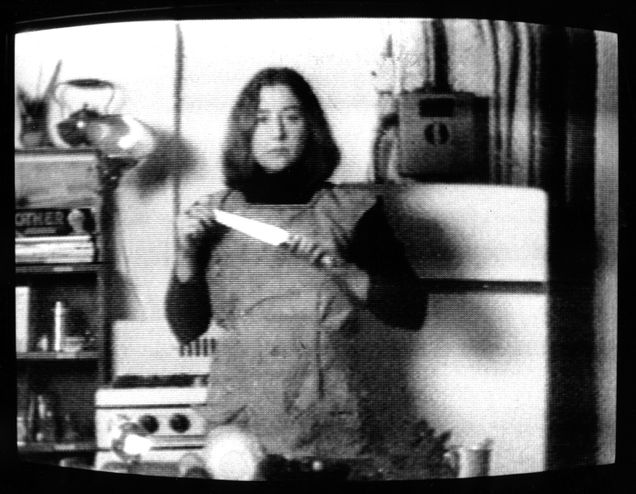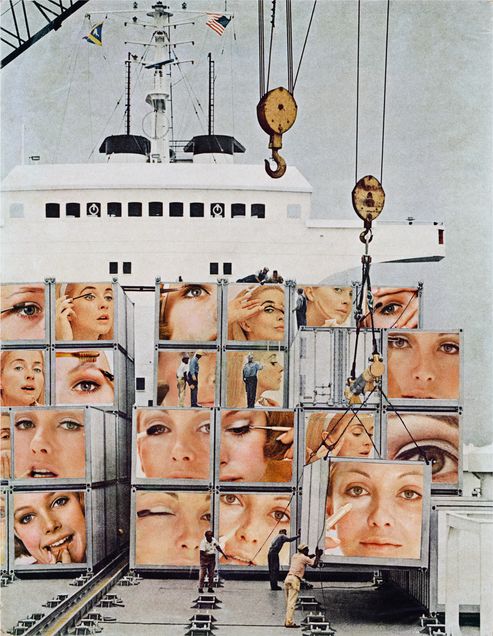Contemporary Perspectives Challenge Existing Narratives
Genre-defying pioneer artist/writer/activist Martha Rosler candidly engages with the SVA community as part of Contemporary Perspectives lecture series
Spark Volume 3, Issue 2 | by Emily White

Camera resting at her side for an informal discussion with Visual Arts faculty and students following the previous night’s lecture, Rosler captured the attention of those around the table with an at once calmly observant and sharply commanding demeanor. Self-identifying as plain-spoken, which “often gets me in trouble” she claims, it is just that candid attitude which imbues into Rosler’s work the challenge for her audience to strip away filters and lenses to reach the root of the themes she explores.
A major early voice for feminist art practice, Rosler’s art and voice has been inextricably tied with her activism for over four decades. Her antiwar photomontages, video and performance pieces like “Semiotics of the Kitchen,” and public installations from the Martha Rosler Library to traveling Garage Sales invite us to question ideological frameworks that color our relationship to the visual. Much of her work relies on public space and explores the ways in which people exist in the world. Through conversation, and with word and image juxtaposed, her work is designed to attract attention to its subject. “It is what it is,” Rosler bluntly states.
Having been active and vocal on combating social injustice for decades, Rosler’s incisive work challenges the viewer to face uncomfortable truths. Truths like recurrent and devastating wars. Endemic oppression which poisons marginalized groups generation after generation. Sisyphean cycles of homelessness and consumerism. Her work serves as a vehicle for conversation, and more so a mirror which draws us out of our comfortable perspectives and familiar bubbles.

“I realized that I could use the technique of interruption and recombination to draw attention to that invisible separation between ‘here and there’ and ‘us and them,’” says Rosler. Much of that interruption and reframing is found in language. In its many forms, language permeates Rosler’s art, much like her characteristically biting humor infiltrates conversation. A lover of words, she draws on the “inescapable ambiguity of human utterance” because “language is ultimately ambiguous at a certain level” and yet we rely on it day-to-day, moment-to-moment, to convey information, understanding, caution, emotion, knowledge, and self-expression.
Exploration of space and language converge in The Bowery in two inadequate descriptive systems (1974-75). This piece composed of gelatin silver prints of text and image demonstrates the interplay of text and image by framing scenes of shuttered storefronts with typewritten words associated with drunkenness; descriptions juxtaposed with photographs lacking people. Turning the often-exploitative documentary photography genre inside out, Rosler addresses both a social injustice and the inadequacy of both descriptive systems – text and image – to convey the complete truth.
“I grew up with stories. I was a crazy avid reader…always searching for ways to define experience.” Rosler’s exploration of photography brought textuality into play in unique ways. “It’s language that frames our relation to the world and our relation to images” and remains the primary mode of understanding and engaging with the world around us. A valuable lesson in today’s image-saturated culture of filtered posts and ubiquitous tweets, Rosler repeated the mantra to never trust a single image. She set out to “demolish the notion of photography as a single frame,” and through the intentional combination of image and text presented a transgressive statement to the established order. “Adding language brings [the conversation] back out into the social and the shared.”
Rosler uses humor and irony as a kind of disruption that has a power in the narratives she draws, but warns, especially in a social media-warped society, “the transmissions of language are tricky” and dangerous if misinterpreted. “Art does not change society…social movements and people working in concert do,” says Rosler. In a distinct way, this Contemporary Perspectives visiting lecturer emphasized the importance of art in sparking conversation with the hope of changing the repetitive cycle of history before we forget the mistakes and injustices of our recent past.
One aspect of the magic of language, as expressed in Rosler’s wide array of work, is that it has the power to exist in many ways simultaneously, imbued with meaning by speaker/listener, writer/reader, artist/audience. It is just that multiplicity that Rosler invites openly. “I never want to tell people what the answer is, only what the question is.”
Martha Rosler is an artist, writer, and activist based in Brooklyn, New York. A pioneer of American conceptual photography, video art, performance, installation and feminist art practice, she has had solo exhibitions at the Museum of Modern Art, the Whitney Museum of American Art, the Centre Pompidou in Paris, the Dia Art Foundation, and the New Museum, to name just a few. Since the 1970s, her widely influential work has consistently tackled the most urgent social, aesthetic, and political issues of the day. She is a noted writer with over fifteen published books. This lecture was co-sponsored by the FlashPoint, Boston’s premier photography festival.
Contemporary Perspectives Lecture Series
Each semester, the School of Visual Arts’ Contemporary Perspectives Lecture Series invites renowned professional artists, designers, and critics to engage with the SVA community. Undergraduate and graduate students benefit from exposure to the lecturers’ work, entering into dialogues about the art-making process, as well as benefiting from individual studio visits and critiques. Visiting artist lectures are free and open to the public.